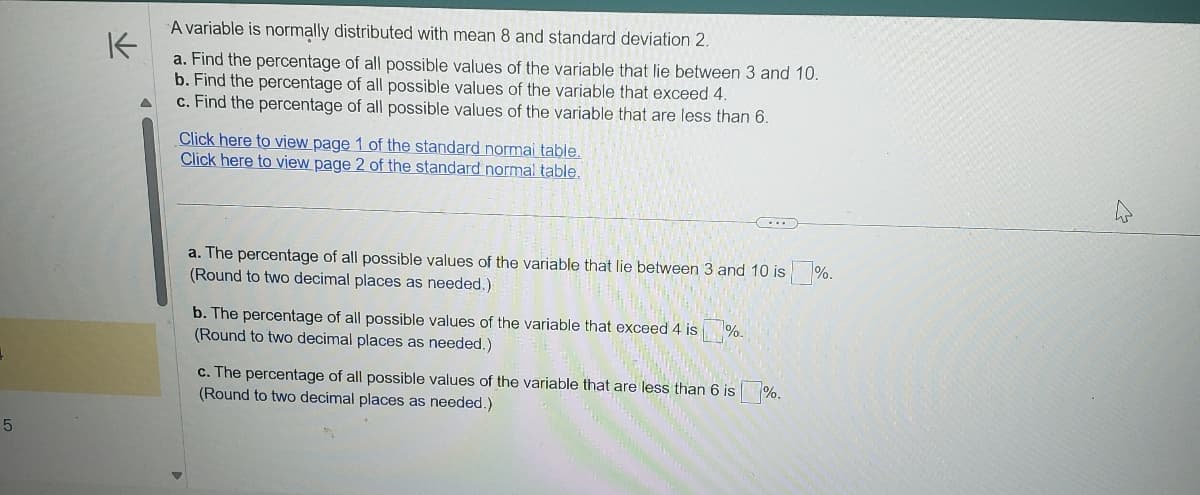K A variable is normally distributed with mean 8 and standard deviation 2. a. Find the percentage of all possible values of the variable that lie between 3 and 10. b. Find the percentage of all possible values of the variable that exceed 4. c. Find the percentage of all possible values of the variable that are less than 6. Click here to view page 1 of the standard normal table. Click here to view page 2 of the standard normal table. + a. The percentage of all possible values of the variable that lie between 3 and 10 is %. (Round to two decimal places as needed.) b. The percentage of all possible values of the variable that exceed 4 is (Round to two decimal places as needed.) 7%- c. The percentage of all possible values of the variable that are less than 6 is %. (Round to two decimal places as needed.) 5
K A variable is normally distributed with mean 8 and standard deviation 2. a. Find the percentage of all possible values of the variable that lie between 3 and 10. b. Find the percentage of all possible values of the variable that exceed 4. c. Find the percentage of all possible values of the variable that are less than 6. Click here to view page 1 of the standard normal table. Click here to view page 2 of the standard normal table. + a. The percentage of all possible values of the variable that lie between 3 and 10 is %. (Round to two decimal places as needed.) b. The percentage of all possible values of the variable that exceed 4 is (Round to two decimal places as needed.) 7%- c. The percentage of all possible values of the variable that are less than 6 is %. (Round to two decimal places as needed.) 5
Glencoe Algebra 1, Student Edition, 9780079039897, 0079039898, 2018
18th Edition
ISBN:9780079039897
Author:Carter
Publisher:Carter
Chapter10: Statistics
Section10.3: Measures Of Spread
Problem 23PFA
Related questions
Question
Please help. Part A

Transcribed Image Text:K
A variable is normally distributed with mean 8 and standard deviation 2.
a. Find the percentage of all possible values of the variable that lie between 3 and 10.
b. Find the percentage of all possible values of the variable that exceed 4.
c. Find the percentage of all possible values of the variable that are less than 6.
Click here to view page 1 of the standard normal table.
Click here to view page 2 of the standard normal table.
+
a. The percentage of all possible values of the variable that lie between 3 and 10 is %.
(Round to two decimal places as needed.)
b. The percentage of all possible values of the variable that exceed 4 is
(Round to two decimal places as needed.)
7%-
c. The percentage of all possible values of the variable that are less than 6 is %.
(Round to two decimal places as needed.)
5
Expert Solution
This question has been solved!
Explore an expertly crafted, step-by-step solution for a thorough understanding of key concepts.
Step by step
Solved in 1 steps

Recommended textbooks for you

Glencoe Algebra 1, Student Edition, 9780079039897…
Algebra
ISBN:
9780079039897
Author:
Carter
Publisher:
McGraw Hill

Glencoe Algebra 1, Student Edition, 9780079039897…
Algebra
ISBN:
9780079039897
Author:
Carter
Publisher:
McGraw Hill